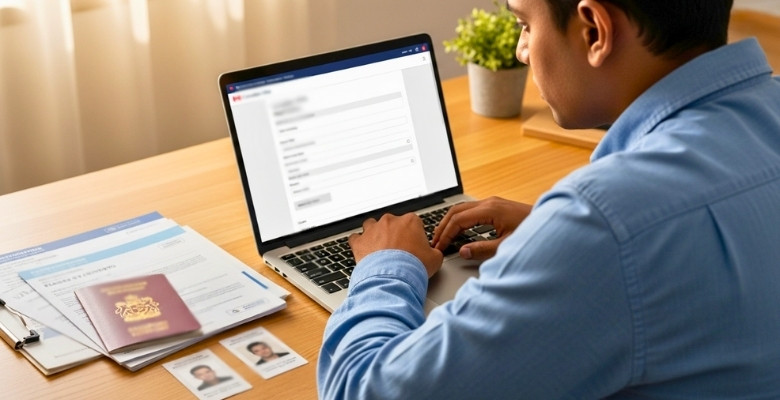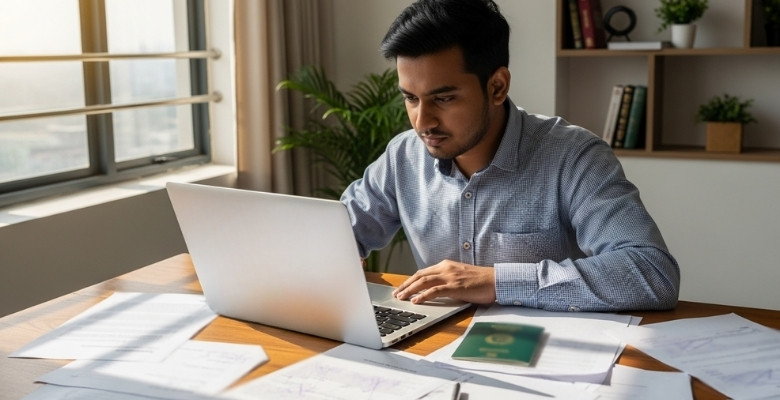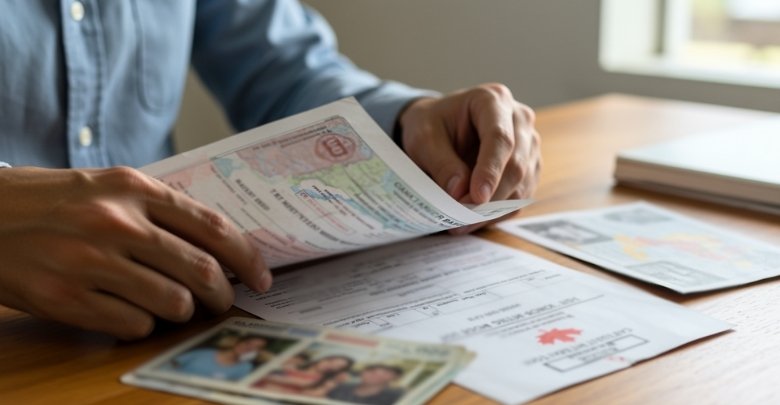Getting a Canadian visitor visa has become more challenging in recent years. Many people still apply with hope, but not all get approved. If you’re planning a short trip for tourism, family, or an event, you might already be wondering what are the odds of getting a visitor visa for Canada?
The odds of getting a visitor visa for Canada vary by country, but overall approval rates have dropped. In 2024, the Canada visitor visa acceptance rate stood at about 46%, while 54% of applications were declined. Strong home ties, clear travel plans, and full documents improve your chances of success.
If this topic has caught your interest, you’re not alone. Many people want to understand how they can improve their chances. In this article, you’ll find everything important to know about this topic, explained in a simple and helpful way.
What Are the Odds of Getting a Visitor Visa for Canada?
Millions apply for a Canadian visitor visa each year, but approval is never guaranteed. Success depends on country, background, and application strength. Some nations face rates below 40%, while in 2024, refusal exceeded 60% in certain regions. Officers assess purpose, home ties, finances, travel history, and file quality. Strong, accurate documents prepared early greatly improve the odds of approval. Several key factors play a direct role in shaping your chances.

Core Factors That Decide Your Chances
- Country-specific Differences: Where you apply from makes a big difference. Applicants from regions with strong travel histories and lower overstay risks often see higher approval rates. Others face higher refusal odds due to visa misuse or immigration concerns.
- Purpose of Visit: Officers want to clearly understand why you are coming to Canada. A well-documented purpose, such as attending an event, visiting family, or even a global conference in Canada with a detailed itinerary, makes your application look genuine and credible.
- Home Ties: Showing strong ties to your home country is one of the most important parts of your file. Employment letters, property deeds, school enrollment, or dependent family members prove that you have reasons to return after your trip.
- Financial Proof: Visa officers need to be confident that you can pay for your entire trip without financial hardship. Providing 3–6 months of consistent bank statements and income records helps show that your funds are real, reliable, and sufficient.
- Travel History: A positive travel record shows that you respect visa rules and return home on time. If you’ve previously visited countries like the US, UK, or Schengen states without overstays, it strengthens your credibility and makes approval more likely.
- File Quality & Timing: Even the smallest mistakes, like missing signatures or mismatched dates, can raise red flags. Submitting a clean, complete application at least 2–3 months before your travel date shows preparation and helps avoid last-minute refusals.
- Rejection Trends: Visitor visa approvals are no longer as high as they once were. In past years, the global average hovered around two-thirds, but today many applications face refusal because of weak documents, unclear travel purposes, or doubts about intent to return. With stricter rules, even small mistakes can lead to rejection, lowering overall success rates.
Visa Odds Self-Check
Before applying, ask yourself:
- Do I have a clear reason for visiting with supporting evidence?
- Can I prove strong ties to my home country?
- Do my bank records show enough funds for my trip?
- Is my travel history clean, without overstays?
- Have I double-checked all forms and documents for errors?
While statistics give a general picture, your own odds of approval depend entirely on the strength of your personal application. Immigration officers review every case individually, weighing purpose, funds, ties, and history together. Focusing on clear, honest, and consistent documents is the best way to improve your chances of getting a Canadian visitor visa.
Eligibility Factors That Impact the Odds of the Visitor Visa in Canada
Canada welcomes millions of visitors each year, but not everyone who applies for a visa qualifies. To increase your chances, you need to meet certain conditions that show you’re eligible, responsible, and financially prepared for your stay. Let’s go through the main requirements you should know about.
Valid Passport
You must have a valid passport for the entire duration of your stay. Make sure it won’t expire before or during your planned trip, as this can lead to delays or even refusal.
Age and Consent
If minors apply, they need written permission from a parent or legal guardian. This ensures that the trip is approved and safe. Adults don’t have special age restrictions, but all other general visa rules apply.
Financial Proof
Applicants must show enough funds to pay for their travel, stay, meals, and other expenses. Updated bank statements for the last 3–6 months are often required. A clear financial record makes it easier for officers to approve your application.
Travel History
A good travel history helps prove that you respect visa rules. Showing stamps, past visas, or return records from other countries (especially the US, UK, or Schengen states) strengthens your file.
Criminal and Security Background
Applicants must not pose any risk to Canada. A police clearance certificate is often requested to confirm that there are no serious legal issues. Even minor offences can affect your chances, so honesty is important.
Purpose and Itinerary
Your reason for visiting Canada must be explained in detail. This can include tourism, visiting family, or attending business or academic conferences. Adding travel dates, hotel details, and city names shows that your plan is real and well-prepared.
Proof You’ll Leave After Your Visit
One of the most important conditions is proving that you’ll return home once your visa expires. This can be supported with employment letters, school enrollment, family ties, or property ownership in your home country.
Admissibility (Medical)
In some cases, you may be asked to complete a medical exam to prove that you’re not a health risk to the Canadian public. This usually applies for longer stays, but it’s part of the admissibility check.
Quick Eligibility Checklist
- Valid passport
- Clear reason for visiting with travel details
- Enough funds for your stay
- Good travel history
- No serious criminal record
- Medical exam completed if required
- Proof you’ll return home (job, family, property, or school)
Meeting these requirements doesn’t guarantee approval, but failing to meet even one of them can almost always result in refusal. The stronger and more consistent your documents are, the better your chances of getting a Canadian visitor visa.
How to Apply for a Canadian Visitor Visa Properly?
Every step in the visa process matters, and small mistakes can cause long delays. The best way to avoid problems is to prepare carefully, submit the right documents, and keep an eye on your online account for updates. If you ever feel unsure, ask for help before submitting your application. Here are the key factors that shape your chances of approval.
Quick Checklist Before You Apply
- Valid passport (not close to expiry)
- Enough funds for your entire stay
- Clear reason for visiting (tourism, family, events, etc.)
- Proof you’ll return home (job, family, school, property)
- No serious medical or criminal issues
Step 1: Check If You Qualify
Before you start, make sure you meet the basic requirements. You must prove you can support yourself financially, that you’ll return home after your visit, and that you don’t have medical or criminal barriers. Strong proof of ties, such as a job or family, will help your case.
Step 2: Collect All Required Documents
Gather your passport, two recent photos, bank statements, and travel details. If a family member or friend is inviting you, include their letter of invitation. Every document should be clear, valid, and in the correct format. Missing or fake documents almost always lead to refusal.
Step 3: Open an Online Account With IRCC
Go to the official IRCC website and create your online account. This is where you’ll complete forms, upload documents, pay fees, and track progress. Keep your login secure and check for updates regularly. Online filing is the standard way to apply.
Step 4: Fill Out the Forms and Upload Documents
Use your IRCC account to complete the forms carefully. Most applicants will need IMM 5257 (Application for Visitor Visa) and IMM 5645 (Family Information). If someone helps you, also include IMM 5476 (Use of Representative). Double-check spelling, dates, and details before uploading.
Step 5: Pay the Application and Biometrics Fees
Fee Summary
- Visitor visa fee: CAD 100 per person
- Biometrics fee: CAD 85 per person
- Family cap: CAD 500 (visa) / CAD 170 (biometrics)
You must pay online with a debit or credit card, then keep a copy of your receipt. Without payment, your application won’t move forward.
Step 6: Give Your Biometrics
Most applicants need to give fingerprints and a photo at a Visa Application Centre. You’ll get a Biometric Instruction Letter after applying, and you must book an appointment within 30 days. Bring your passport and the letter. Note: biometrics are valid for 10 years, so if you’ve given them before, you may not need to do it again.
Step 7: Wait for Processing
After submitting, your file will be reviewed by IRCC. Processing times vary by country and season, so keep checking your account for updates. If additional documents are requested, send them quickly to avoid delays.
Step 8: Send Your Passport for Visa Stamping
If your application is approved, IRCC will ask you to submit your passport so they can attach the visa counterfoil inside. Follow the instructions carefully for courier or drop-off. Once it’s returned, review the details on your visa to ensure everything is correct.
Step 9: Get Ready to Travel
When your passport comes back, you can confirm your travel plans. Keep your passport, visa, return flight, hotel booking, and any invitation letters ready to show at the airport. Border officers may ask questions about your visit, so answer honestly and confidently.
Applying for a Canadian visitor visa is a step-by-step process that requires care and attention. By staying organized, paying on time, and double-checking details, you can reduce the chance of delays and give yourself a better chance at approval.
How a Strong Purpose of Visit Letter Can Improve Your Chances?
The success of a visitor visa application often depends on how clearly you explain your intent. Immigration officers want to see a transparent, honest reason for your trip, and that’s where a strong purpose of visit letter becomes essential. It not only tells them why you want to come to Canada but also reassures them that your stay is temporary and genuine. Applicants who fail to explain their purpose properly often face rejection, even if other documents are in order.
Writing this letter gives you the chance to outline the exact reason for travel, such as tourism, family visits, or professional events like conferences or meetings. When these details match your supporting documents—hotel bookings, conference registration, or invitation letters—they create a consistent story. Consistency matters because even small mismatches raise doubts in the officer’s mind. For example, saying you want to attend a business meeting but not including proof of the event could hurt your chances.
The letter also adds a personal touch that official forms cannot. By including details about your work, family, or responsibilities back home, you show strong ties that make it more likely you will return. Officers are trained to look for red flags that suggest someone might overstay, and a convincing purpose of visit letter helps reduce those concerns.
How to Write a Strong Purpose of Visit Letter for a Canada Visitor Visa?
Writing a purpose for a visit letter is a key part of your visa application. It gives you the chance to explain why you want to visit Canada in your own words. If written clearly and honestly, it can add strong support to your file. To make it easier, here are the main steps you should follow when writing your letter.
Step 1: Write Your Personal Introduction
Begin by introducing yourself with basic details: full name, passport number, age, and current address. Mention your occupation, whether you are employed, self-employed, or a student. Keep it short and straightforward.
Step 2: Clearly Explain Your Reason for Visiting
State the main reason for your visit. It could be tourism, visiting family, business meetings, or attending an event. Applicants who plan to join professional events should make sure their explanation matches the visa requirements for Canadian conferences, as officers will carefully check that the purpose aligns with official guidelines.
Step 3: Mention Trip Dates and Travel Plans
Provide your planned arrival and departure dates, where you will stay, and the cities you intend to visit. If you already have bookings, you can mention them briefly. Consistency across your documents is very important.
Step 4: Show Strong Reasons You Will Return Home
Officers want to be confident that you’ll go back after your visit. Mention commitments such as your job, school, business, or family responsibilities. Even one or two strong reasons are enough if they are clear and supported by evidence.
Step 5: End with a Polite Closing Statement
Thank the visa officer for their time and confirm you will follow Canadian rules. Add your contact information and the date. A respectful closing leaves a positive impression.
Letter Writing Checklist
- Full personal details (name, passport number, address)
- Clear reason for visiting
- Travel dates and planned stay details
- Proof of strong ties to the home country
- Polite and respectful closing
Sample Purpose of Visit Letter
To:
Visa Officer
Immigration, Refugees and Citizenship Canada (IRCC)
Subject: Purpose of Visit to Canada
Dear Visa Officer,
My name is [Your Full Name], and I am [Your Age] years old. I currently work as a [Your Job Title] at [Company Name]. My passport number is [Your Passport Number], and I live at [Your Address].
I would like to visit Canada from [Planned Arrival Date] to [Planned Departure Date]. The purpose of my visit is [tourism, family visit, attending a business meeting, or event]. I plan to stay at [Address of Stay in Canada] during my trip, and I may also visit [Names of Cities or Places].
To confirm my return, I have attached proof of my job, leave approval, and family commitments in [Your Country]. I have also included my travel bookings and other supporting documents.
I assure you that I will follow all Canadian visa guidelines and return home before my visa expires. Thank you for your time and consideration.
Sincerely,
[Your Full Name]
(Signature)
[Date]
This letter should always match the details you provide in your application forms and documents. Contradictions between your letter and your file can raise red flags. Keep it short, honest, and consistent for the best results.
Biometrics and Fees: Do They Affect Your Visitor Visa Odds?
Biometrics are mandatory for almost all visitor visa applicants, and paying the required fees is part of the process. They affect the visitor visa odds, but many applicants are unsure about who needs them and what the costs are. The process is straightforward once you understand the basics, and knowing what to expect will help you stay prepared. Let’s go over who needs biometrics, how fees work, and what the process looks like:
Who Needs Biometrics and Where to Give Them
Most applicants between 14 and 79 years old must provide biometrics, which include fingerprints and a photo. This is done at a Visa Application Centre (VAC) or an Application Support Centre. If you’ve already given biometrics for Canada in the past 10 years, you may not need to do them again. You’ll find out if they’re required when you log in to your IRCC account.
Visa and Biometrics Fees
Here are the standard fees for visitor visas:
- Visitor visa: CAD 100 per person
- Biometrics: CAD 85 per person
- Family caps: CAD 500 for visa fees and CAD 170 for biometrics
These fees are paid during your application process through your IRCC account.
Typical Order of Events
Once you apply and pay the required fees, you’ll receive a Biometric Instruction Letter (BIL) in your account. With that letter, you book an appointment at your nearest VAC. After completing your biometrics, the system updates your application status, and your file continues through the processing stage.
Completing biometrics and paying the correct fees are non-negotiable parts of the visitor visa process. By following the instructions in your IRCC account and finishing this step on time, you keep your application moving without unnecessary setbacks.
Processing Times and Your Visitor Visa Odds
Processing times themselves don’t directly change your odds of approval, but they play an important role in how strong your application appears. Many refusals happen when applicants rush, submit incomplete documents, or apply too close to their travel dates. By understanding how long it usually takes, you can apply early and avoid the kind of mistakes that lower approval chances.
The official IRCC processing time tool gives the most reliable estimate for your case. It shows the average wait based on your country of residence and the type of visa. For example, some regions may process visitor visas in just a few weeks, while others may take several months.
How to Use the Official Tool
The best way to know your expected wait is through the IRCC processing time tool. For example, the Canada visitor visa processing time can change depending on your country of residence, and the tool gives you the average range based on current applications.
- Go to the official IRCC processing-time page.
- Select “Visitor Visa” and choose your country of residence.
- The tool will show you the average range of days or weeks based on current applications.
- Remember that the time shown is an estimate, not a guarantee.
What Can Change Processing Times
A few things can make your application take longer than the estimate:
- Biometrics – If you’re asked to give fingerprints and a photo, the clock may pause until that step is complete.
- Medical exams – Some applicants need a medical test, which adds extra time.
- Additional documents – If IRCC requests more proof, the review won’t continue until you submit them.
- Application volume – During peak travel seasons, offices handle more files, which can slow down processing.
Checking your processing time through the official IRCC tool gives you the most reliable estimate for your case. While delays can happen, applying early and ensuring your file is complete helps you avoid unnecessary waiting. Keeping an eye on IRCC updates for visitor visa processing is also useful, since changes in policy or workload can directly affect timelines.
How to Prove Strong Ties to Your Home Country for a Canadian Visitor Visa?
One of the main reasons visitor visa applications get refused is when officers are not convinced the applicant will return home after their trip. Showing strong ties to your home country is the best way to avoid this. These ties can be demonstrated through documents that prove your commitments, responsibilities, and reasons to return.
Documents That Prove Strong Ties
- Employment & Business
- Job verification letter with position, salary, and approved leave dates
- Business license, tax returns, or financial statements (if self-employed)
- Education
- Enrollment letters, transcripts, or proof of upcoming semesters (for students)
- Family & Community
- Marriage or birth certificates proving family responsibilities
- Evidence of dependents, such as children or elderly parents
- Letters from community or religious organizations showing active involvement
- Property & Finances
- Real estate deeds, rental agreements, or ownership papers
- Bank statements and investment portfolios showing long-term commitments
- Travel Plans & Return Proof
- Booked a return flight ticket
- Invitation letter from the host in Canada (if applicable)
- Personal Statement
- A short letter explaining why you will return home (job, family, school, or property responsibilities).
The stronger and more consistent your evidence is, the easier it is for an officer to believe you’ll return home after your visit. Presenting multiple forms of ties, job, family, property, and finances, greatly increases your chances of approval.
How Much Bank Balance Is Required to Increase the Chances
When applying for a Canadian visitor visa, one of the most important requirements is showing that you have enough money to cover your trip. There isn’t an official minimum amount set by IRCC, but immigration officers expect to see funds that realistically match your travel plans. Many applicants often wonder what an ideal bank balance for Canada Visa should look like, and while it varies, here’s a quick reference table with practical ranges to guide you.
Recommended Bank Balance Ranges
| Scenario | Recommended Funds (CAD) | Notes |
| Short Visit (1–2 weeks) | $4,000–$6,500 | Covers airfare, hotel, meals, and small activities. Works for tourists or short business trips. |
| One-Month Stay | $6,500–$8,000 | Includes food, lodging, and local transport. Adjust based on city (Toronto is higher than smaller towns). |
| Longer Stay (3–6 months) | $10,000–$12,000+ | For extended visits. Should fully cover living expenses for the duration. |
| Add per Family Member (monthly) | +$1,000–$2,000 | Add this range for each family member, depending on their age and needs. |
| Staying with Friends/Relatives | $4,000–$5,000 | Costs can be lower if accommodation or meals are covered. Include the host’s letter and financial proof. |
| Sponsored Visit | Varies | If sponsored, include the sponsor’s financial documents, a sponsorship letter, and proof of relationship. |
Proof of Funds Checklist
- Last 3–6 months of bank statements
- Pay stubs or proof of employment
- Tax returns (if available)
- Proof of accommodation (hotel booking or invitation letter)
- Sponsorship letter and financial proof (if trip is funded by someone else)
Note: These amounts are general recommendations, not official minimums. Visa officers review each application individually, and the exact requirement depends on your trip length, family size, and where you plan to stay.
For detailed calculations, check the Proof of Funds: Estimator & Examples section above.
Common Mistakes That Can Reduce Canada Visitor Visa Approval Odds
Applying for a Canadian visitor visa may look simple, but even small errors can cause rejection. Many applicants get refused because of details they could have avoided with a bit more preparation. Here are the most frequent mistakes and how you can avoid them.
- Incomplete Documentation: Missing forms, unsigned papers, or forgotten attachments often result in instant refusal. Visa officers expect a complete file from the start.
- Incorrect Information: Any false or mismatched detail, even by mistake, can lead to rejection. Always double-check that your application matches your supporting documents.
- Insufficient Financial Proof: Low or unclear bank balances raise doubts. Applicants must show enough funds for tickets, accommodation, and daily expenses.
- Vague Travel Itinerary: Submitting unclear or half-done plans signals weak travel intent. A detailed plan of where you’ll stay, visit, and for how long makes your case stronger.
- Ignoring Visa Interview Preparation: Some applicants go unprepared for the interview. Being able to confidently explain your travel purpose and ties to home improves your chances.
- Overlooking Ties to Home Country: Not providing proof of employment, school, family, or property weakens your case. Officers must be convinced you will return after your trip.
- Applying too Close to Travel Dates: Submitting your application last-minute often leads to delays or outright refusals. Applying at least 2–3 months ahead is safer.
- Mismatch Between Forms and Documents – Even small inconsistencies (like different dates in your hotel booking and itinerary) can trigger red flags. Consistency is key.
Even a small mistake can harm your chances of getting approved. Taking extra time to review your application, checking for consistency, and preparing supporting evidence properly will greatly improve the odds of success.
How Reapplying After Refusal Can Change Your Visa Approval Odds?
Reapplying after a refusal can significantly affect your visa approval odds, depending on how you handle the process. A rejection highlights gaps in your previous application, and fixing those weaknesses gives you a stronger chance the next time. Instead of seeing refusal as the end, treat it as an opportunity to rebuild your case with clearer proof and better preparation. Here are the steps:
Step 1: Understand the Reason
Every refusal comes with a letter explaining why the officer said no. Common reasons include weak financial proof, unclear travel purpose, or not enough ties to your home country. Read this letter carefully so you know exactly what needs to be fixed.
Step 2: Reapply, Don’t Appeal
There is no formal appeal process for visitor visa refusals. The only option is to reapply. This time, you must include stronger documents or new information. Submitting the same file without changes will almost certainly lead to another refusal. Note that you will need to pay the visa fee again.
Tip: In very rare cases, a judicial review in the Federal Court may be possible, but this is complex and requires legal advice. For most applicants, reapplying with better proof is the practical option.
Step 3: Decide When to Reapply
You don’t have to wait a set number of days after refusal. However, reapplying immediately without changes is risky. Take a few weeks or longer to collect stronger evidence, correct mistakes, and prepare a clearer file. Officers often notice when applicants rush, which can hurt their case.
Step 4: Fix Common Issues
Many refusals happen because of:
- Low or unclear bank balances
- Weak travel plans or vague itineraries
- No strong ties to home country (job, family, property, or school)
- Errors or inconsistencies across forms and documents
Strengthening these areas gives your next application a much better chance. Always make sure your details are consistent and easy to understand.
A refusal is not the end of your Canada plans. It’s a chance to learn what went wrong and prepare a stronger application. By fixing the weak points, adding better proof, and applying with confidence, your next attempt can stand a much higher chance of approval.
Frequently Asked Questions
There are many small but important things people often wonder about when applying for a visitor visa to Canada. These questions can help you understand how your chances are affected by different situations. If you’re planning to apply soon, reading these answers can really help. Let’s look at some of the most asked questions below.
Can A Travel Ban Affect My Visa Chances?
Yes, travel bans can make it harder to get a visa approved. If Canada has placed travel restrictions on your country, your chances can go down. It doesn’t mean you can’t apply, but approval is less likely. Always check if any bans or warnings are active before you apply.
Do Visa Agents Improve My Chances?
Visa agents may help with paperwork, but they don’t guarantee approval. The officer will still check your documents and reason for travel. If your file is weak, even the best agent can’t change the result. You must give real, clear, and honest information in your application.
Does A Friend’s Approval Help My Case?
Just because your friend got a visa doesn’t mean you will too. Every application is checked on its own based on your documents. Officers don’t compare you with others when making a decision. Focus on making your file strong instead of relying on others’ success.
Will A Letter From A Canadian Help?
A letter from someone in Canada can support your visit plan. But that alone won’t make your visa get approved. You still need strong proof of money, return plans, and documents. The letter just adds support but doesn’t replace the required documents.
Can A Student Visa Rejection Affect My Visitor Visa?
If your student visa was refused, it might affect your visitor visa a little. Officers may check what went wrong in the past refusal. If you now apply with better documents and a different reason, it may still get approved. Always fix old issues before applying again.
Does My Visa Type Matter For Approval?
Yes, different visa types are checked in different ways. A visitor visa is for short trips, so it’s checked for strong ties and money proof. If your reason matches the visa type, your chances are better. Always choose the correct type of visa for your travel plan.
Will Applying With Family Increase My Chances?
Applying with family doesn’t always make it easier, but it can help. Officers may see it as a planned group visit, which feels more real. But each person still needs strong documents and reasons. One weak file can affect the whole group’s result.
Can I Still Get Approved With No Job?
Yes, but it’s harder to prove you’ll return home without a job. You’ll need to show other strong reasons, like property or school. If you show you won’t overstay, it may still work. Try to explain your return plan clearly in your application.
Does My Visa Get Checked By Multiple Officers?
Most times, only one officer checks your file and makes a decision. But sometimes, another officer may check again if something is unclear. This doesn’t happen in every case, but it’s possible. That’s why your documents must be clear and complete from the start.
Will Giving Extra Documents Help My Chances?
Extra documents can help, but only if they are useful and real. Don’t add too many papers that repeat the same thing. Make sure each document supports your travel plan clearly. Simple, clear, and correct files work better than long and confusing ones.
Bottom Line
Getting a Canadian visitor visa involves many small but important steps, from collecting documents to proving your plans. Every part of the process matters, and skipping any can affect your results. That’s why being clear, honest, and well-prepared is so important. Whether you’re applying for tourism, visiting someone, or attending an event, staying organized will help.
So, what are the odds of getting a visitor visa for Canada? The current approval rate is 46% and the rejection rate is around 54%, which means only about half of all applicants get approved. According to the latest figures, the visitor visa acceptance rate Canada continues to depend heavily on your country, financial proof, travel history, and home ties. The stronger your application, the better your chance of approval.
Before you apply, take your time to prepare everything properly. Avoid rushing, double-check your details, and be ready with complete documents. Make sure your reason to visit is clear and your return plans are strong. Good luck on your application, and may your Canadian travel plan go smoothly!











